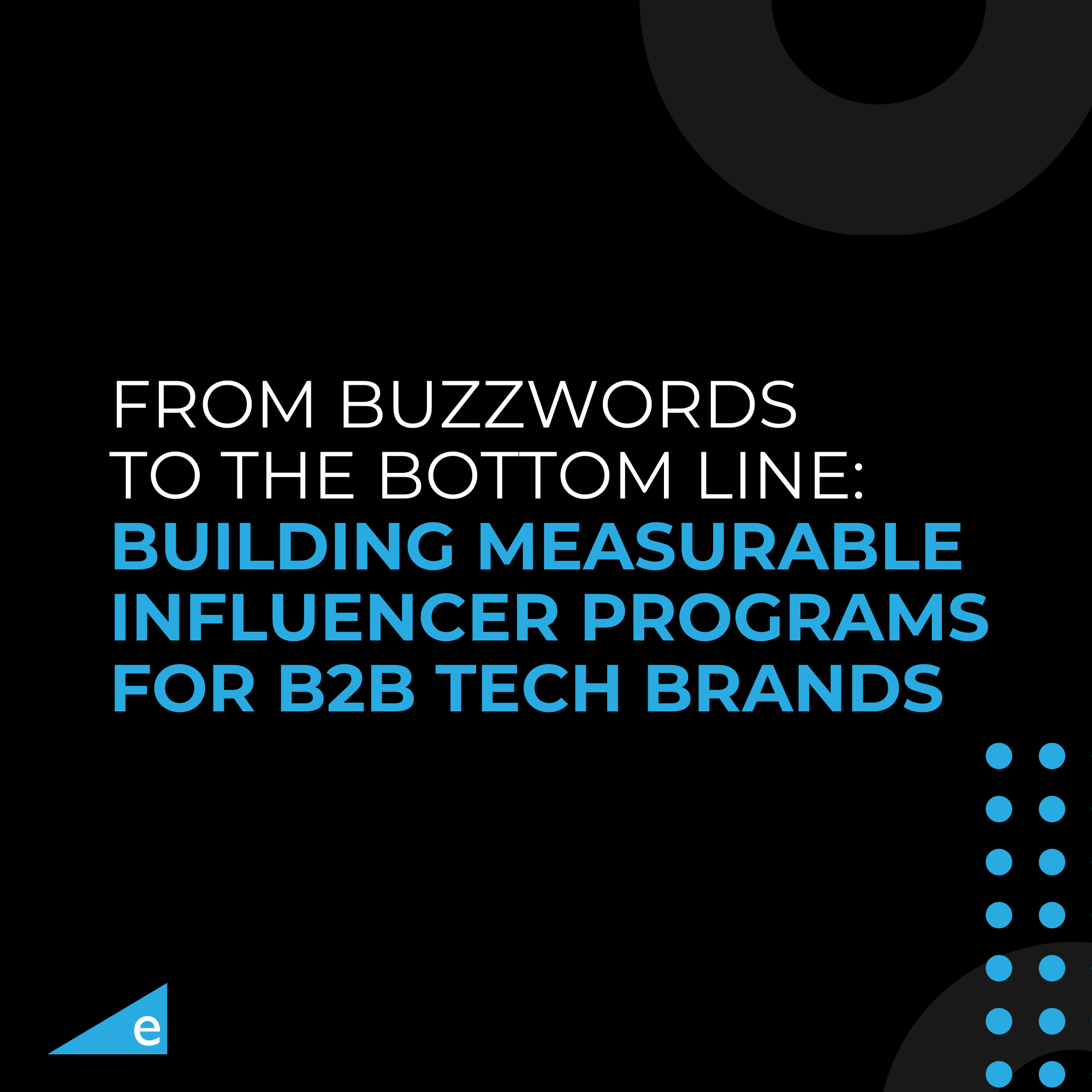From Buzzwords to the Bottom Line: Building Measurable Influencer PR Programs for B2B Tech Brands

Laura Rodriguez, SVP at Escalate PR, here to talk about building influencer PR programs for B2B tech brands. Now, I know what you’re thinking – influencers are all about consumer brands – clothing, beauty products, and travel, right? Wrong! A whopping 94% of B2B buyers will research a product online before finalizing a purchase. For as long as I’ve been working in PR and Marketing, organic traffic from word-of-mouth continues to be at or near the top of the performance marketing leader board for new customer acquisition channels. This underscores why strategic influencer marketing, which amplifies both online visibility and credible word-of-mouth recommendations, is so crucial for B2B brands seeking to reach and persuade their target audiences.
In the B2B world, influencers (and maybe not as you’ve thought of them before) are the key to unlocking genuine trust and driving real business results. So, let’s ditch the jargon and dive into how you can make this work for your B2B tech company.
1.Customer Ecosystem: Your Untapped Brand Advocate Goldmine
Think about it: Who’s more credible than a happy customer raving about your product? They’ve been in the trenches, solved problems, and seen the ROI. This is where your customer or as we like to call it “raving fan” ecosystem comes in.
- Prompt for Reviews and Testimonials: Don’t be shy! Ask for reviews on platforms like G2, Capterra, or even LinkedIn. And go beyond text. Capture video testimonials that show real faces and real stories. According to a study by Wyzowl, 87% of video marketers report that video has increased traffic to their website.
- Referral Incentive Programs: Make it worth their while. Offer discounts, upgrades, or even cash for successful referrals that convert. It’s a win-win.
- Content Distribution: Don’t let those amazing testimonials sit on a shelf. Blast them out! Share them on your website, social media, paid ads, and in email campaigns. Put together case studies that show how your products have solved real-world problems.
2.Empowering Your Partner Ecosystem: Their Success is Your Success
Your partners are your extended family, and their success directly translates to yours. They’re on the front lines, selling your products and supporting your customers. Let’s equip them for victory! Enable them to win and watch customer acquisition, product adoption, revenue, and retention grow. In some organizations, partner programs have been known to drive up to 50% of annual revenue, highlighting the ecosystem’s crucial role in overall business success. By empowering your partners, you’re not just expanding your reach; you’re fostering a mutually beneficial relationship that fuels growth for everyone involved.
- Empower Them with Content: Make it easy for them to share your content on their websites and social media. Create co-branded assets, like webinars or infographics, that showcase the value of your joint solutions and educate customers about the problems you are trying to help them solve.
- Build a Community: Treat all your partner types like VIPs. Host exclusive events, offer exclusive training, competitive sales incentives, and create a community or closed forum for them to connect with each other, the customer base, and the brand. When they succeed, you – and your customers succeed – everyone wins.
- Product Integration or Business Development Partnerships: Team up with other tech brands you have product integrations with to bring a “better together” solution to both customer bases. Co-create content that shows how your products work together. This expands your reach, adds new revenue streams, and adds credibility. Leverage business development partnerships to cross-sell products to each other’s customer bases.
Partner Testimonials & Awards: Attract new partners by showcasing the success stories of your current ones. Reward and recognize your most active and successful partners to celebrate their success.
3. Identifying and Activating “Traditional” Online and Social Influencers
To effectively leverage online or social media influencers in B2B tech marketing, first, understand your ideal target customer. Where do they spend time online? Who do they trust for recommendations? Think about their demographic and psychographic characteristics, too. If you sell local internet services to small businesses you may look for small business influencers in each local market with some notable reach. Focus on influencers who resonate with your target audience and have genuine engagement, not just a large follower count. Are their followers actively participating or just passively scrolling? Consider influencers across various channels:
- Industry Media & Analysts: Build relationships with journalists and analysts (IDC for example) who shape opinions in your field. Share valuable insights and data. Remember, 74% of B2B buyers research online before purchasing.
Social Media Creators: Identify relevant YouTubers, Instagrammers, and TikTokers. Look for those with expertise and influence within your niche, and explore free and paid content engagement and promotional strategies. - Exclusive Experiences: Offer influencers special access at events, behind-the-scenes tours, and interview opportunities with your experts.
- Employee Advocates: Empower your own team to become influencers. Provide training and resources to encourage them to share their expertise and company content on social media.
The Bottom Line Behind B2B Influencer Marketing
Building an influencer program isn’t about throwing money at online celebrities. It’s about creating genuine connections with the people who matter most to your customers and business. It’s about building trust, amplifying your message, and driving real results. So, go out there, find your tribes, and start building and tracking the ROI of those relationships.
